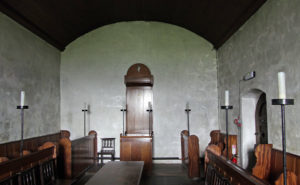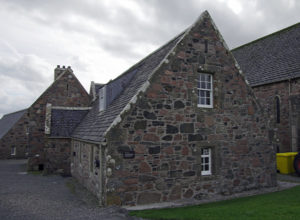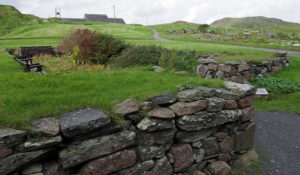Iona Abbey is one of the oldest and most important religious centres in Britain. There is so much history to the place that I have divided the review into four separate parts. The first part covers the history and some background. This part describes the Abbey buildings. Part three concentrates on the Abbey and part four describes the cloisters. The Museum is reviewed “here.”:http://www.silvertraveladvisor.com/review/attraction/168348-review-iona-abbey-museum
All the information and a lot more pictures can be found “here.”:http://wasleys.org.uk/eleanor/churches/scotland/highland/iona_abbey/index.html
Although the buildings of the original Benedictine Abbey have been completely restored or rebuilt, it still retains the original layout from the 1200s.
The Abbey is about 600m walk from the ferry terminal, past the ruined “Nunnery buildings”:http://wasleys.org.uk/eleanor/churches/scotland/highland/iona_nunnery/index.html and the “Parish Church”:http://wasleys.org.uk/eleanor/churches/scotland/highland/iona_church/index.html with MacClean’s Cross. They were originally approached along SRAID NAM MARBH, or the Street of the Dead and part of the cobbled surface can still be seen.
ST ORAN’S CHAPEL on the right hand side of the road before the abbey complex, predates the abbey church, being built around 1150. It may have been built for Somerled, self titled King of the Isles, who had taken control of the area, as the burial place for his family. It has a lovely Norman style doorway with dog tooth carving round it.
It is surrounded by REILIG ODHRAIN, which was the monastic burial ground and also that of the Lords of the Isles. According to legend it was also the burial place of the Scottish Kings, including Macbeth, although there is no evidence for this. It was however used for the burial of clansmen loyal to the MacDonald Lord of the Isles. John Smith, former Labour Party leader, is also buried here. Many of the old burial stones are now preserved in the Museum and around the abbey buildings.
After the Reformation, the chapel was left derelict before being restored along with the abbey buildings in the early C20th.
The inside of the chapel is now empty apart from a couple of wooden benches and small altar. On the floor are old grave slabs and there are more propped up against the wall. On the south wall is a canopied mural tomb, which may have been built for John MacDonald II, the last Lord of the Isles who died in 1503.
It is worth walking round the outside of the abbey buildings first. The church dominates the complex, with the cloisters and associated buildings on the north side.
Standing in front of the church, still in it’s original position is ST MARTIN’S CROSS, dating from around 750. Near it and towering over St Columba’s Shrine is is a replica of ST JOHN’S CROSS. The much eroded and broken original is in the abbey “museum.”:http://wasleys.org.uk/eleanor/churches/scotland/highland/iona_abbey/abbey_six/index.html
Near them is the stone base of ST MATTHEW’S CROSS. Only the shaft and part of one arm survives and is displayed in the museum.
The small stone built ST COLUMBA’S SHRINE to the north of the main door into the abbey church, marks the burial place of St Columba. This dates from around 800, replacing an earlier wooden building and held his shrine with his relics. These were attributed with supernatural spiritual powers and were even toured around Ireland and Scotland. The chapel was restored in 1962 and inside is very simple with a tiny altar with a modern carved wooden cross over it.
Near the door into the abbey is an old stone TROUGH which may have been where pilgrims washed their feet before entering the church. According to tradition, three handfuls of water are thrown into the trough with a request to St Columba to grant a favourable wind before sailing.
On the outside of the south wall of the church can be seen the foundations of a large extension planned to the south transept intended to help manage the flow of pilgrims into the church. It was never completed.
On the east side of the cloisters is MICHAEL CHAPEL, built around the same time as the abbey church. This may have been used by the monks while the abbey church was being built. It was altered in the early C16th when the large east window was added. It was one of the last buildings to be restored in 1959. This was mainly financed by donations from Africa and the stalls and ceiling are African timber. Inside it is a simple chapel, lit with candles with a small altar at the east end and wooden pews along the walls.
The north side of the cloisters is taken up with the Infirmary Building, now the museum, reredorter with the latrine drain running beneath it, and the Abbot’s House.
In a field beyond are the ruins of the C17th Bishop’s House, built when the abbey became temporarily the Cathedral of the Isles, during the reign of Charles I. There are good views across to Mull.
Only the foundations of the bake and brewhouse survive on the east side of the cloister block.This was set apart from the abbey buildings to reduce fire risk.










